Mini-lobsters in a freshwater aquarium? Yes, please!
While not technically a lobster, the dwarf crayfish is an excellent choice for those looking to add a unique touch to the bottom level of the aquarium.
These freshwater bottom feeders have a familiar appearance, with multiple sets of walking legs, pincers, a tough exoskeleton, and a strong swimming tail.
In addition to their visual appeal, these species are a useful part of a tank cleanup crew, helping to rid the tank of algae and detritus.
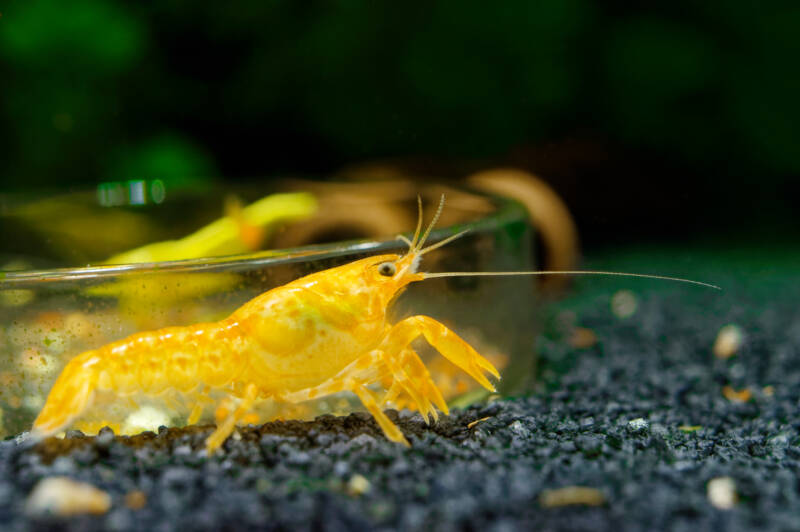
Read on for more information on the care, feeding, and breeding of this species.
[toc]
Varieties/Types of Dwarf Crayfish
There are several species under the broad designation of “dwarf crayfish.” They are typically grouped according to size and color.
The most popular ones you will see in the aquarium trade are:
1. Mexican dwarf crayfish
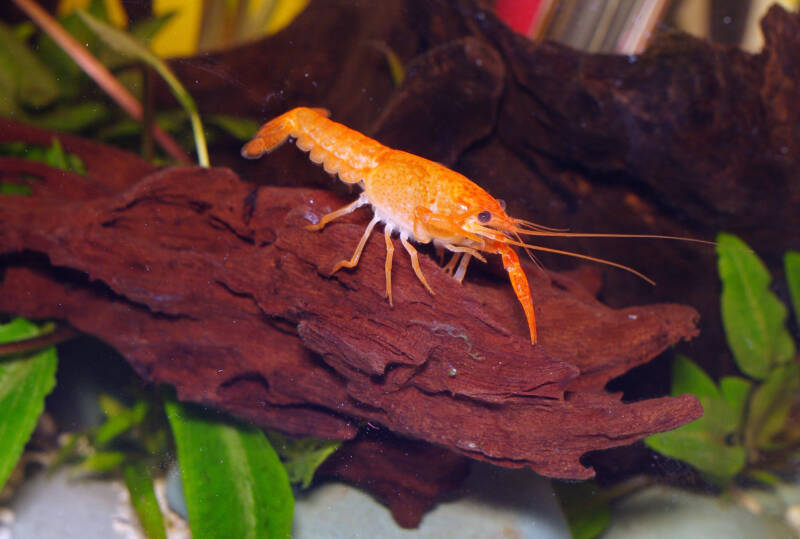
Mexican dwarf crayfish (Cambarellus patzcuarensis), which is also known as the CPO crayfish, orange dwarf crayfish, or Mexican crayfish.
This species has been selectively bred for its bright orange coloration, making it a favorite with aquarium keepers.
2. Brazos dwarf crayfish
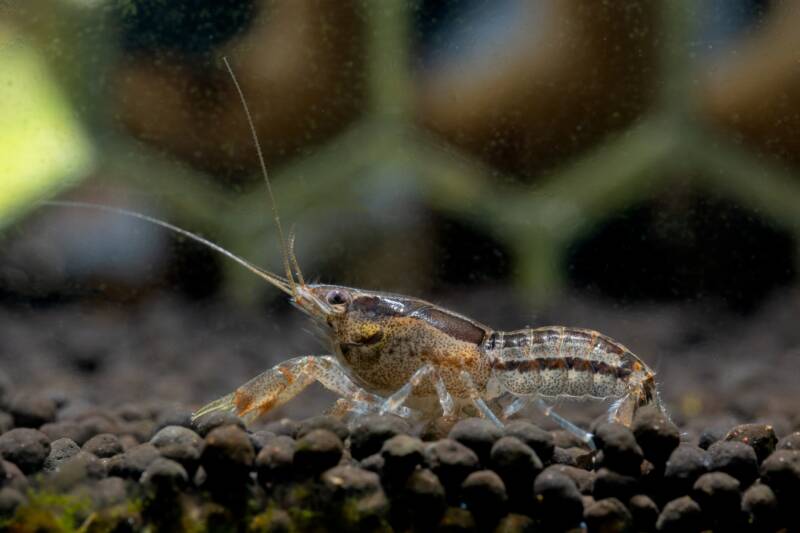
Brazos dwarf crayfish (Cambarellus texanus) olive green or brown.
3. Cajun dwarf crayfish
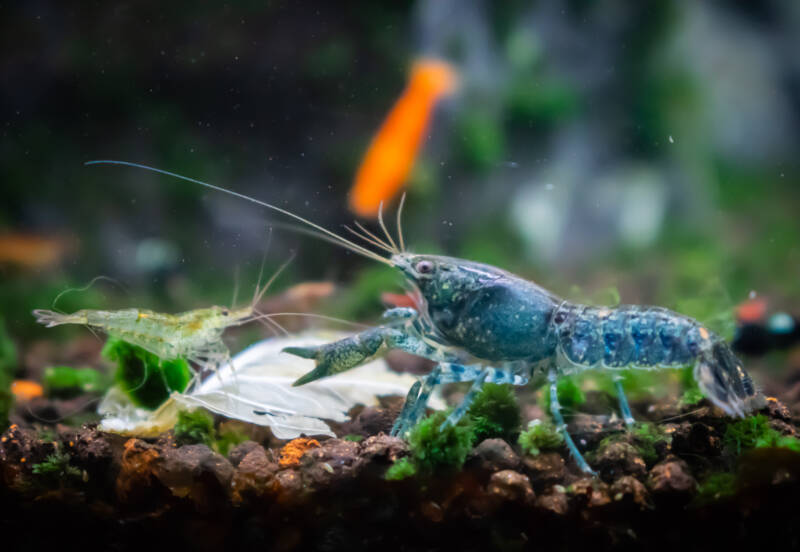
Cajun dwarf crayfish (Cambarellus shufeldtii) two color patterns: brown or blue, striped or spotted.
In this article, we will primarily cover the Mexican dwarf crayfish.
[toc]
At a Glance
| Tank size: | 5-gallons (19 l) for a single crayfish |
| Group size: | Single or small groups |
| Water temperature: | 60–82°F (16 to 28°C) with 65–75°F ideal (18-24°C) |
| pH: | 6.0–8.0 |
| Hardness: | 3–15 dKH |
| Lifespan: | 1.5–3 years |
| Breeding: | Female carries developing eggs |
| Adult size: | 1.6–2 inches (4–5 cm) |
| Usual place in the tank: | Bottom |
Natural Habitat
Dwarf crayfish inhabit shallow freshwaters of the southern United States and northern Mexico.
They prefer slow-moving currents and waters with heavy vegetation.
The Mexican dwarf crayfish comes from the warm water Lake Patzcuaro, in Michoacán, Mexico.
Appearance and Biology
Adorable and tiny, this species has a tough, segmented exoskeleton that is divided into the cephalothorax and abdominal regions.
The front segment features forward limbs with pincers and four sets of walking legs.
On the head, there are several sets of long and short antennae that detect chemical information and help orient the crayfish in the water.
The back end has a powerful tail. Strong abdominal muscles can quickly propel them forward and backward in the water.
Beneath the tail are a series of appendages called swimmerets, which are used for swimming, mating, and for the female to care for her eggs.
Wild dwarf crayfish, which are considered endangered, feature drab olive, brown, or clear colors.
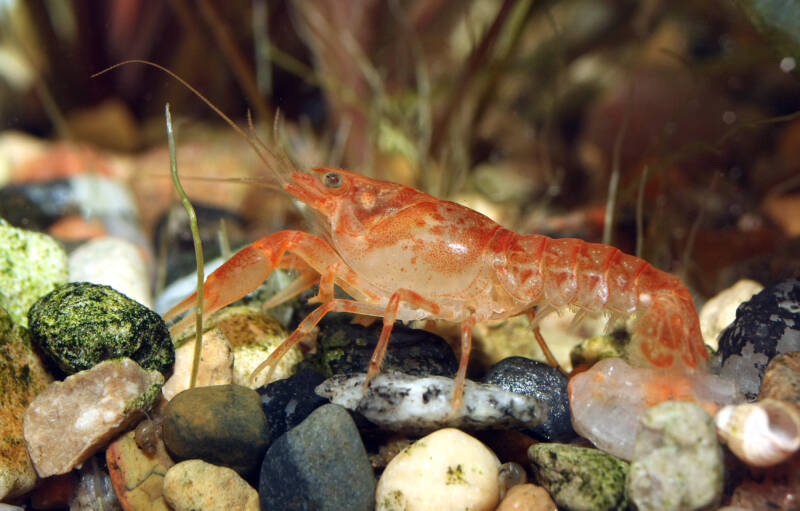
The selectively bred CPO variation displays a bright orange color.
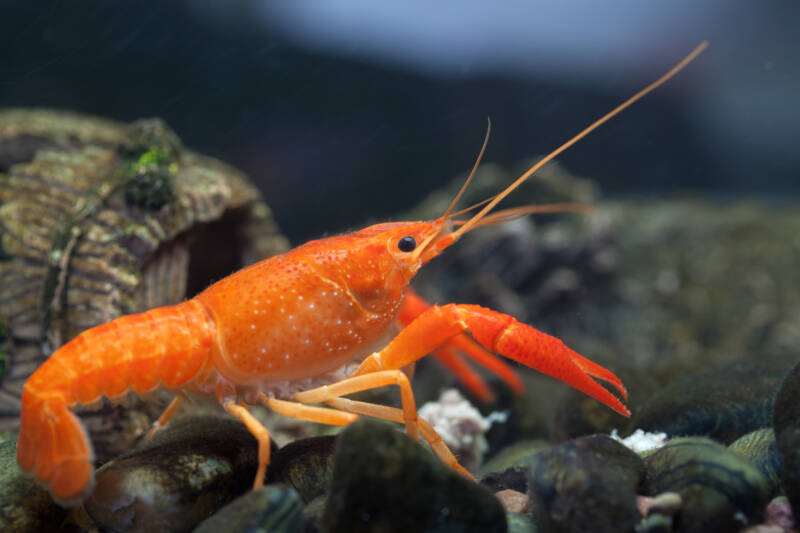
Molting
These animals molt frequently. Adults shed their exoskeleton up to seven times a year.
Young dwarf crayfish molt three to four times a week while juveniles do the same every week or so.
This process is vital to the crayfish as it is necessary for them to replace lost limbs.
As a result, two things are important for your crayfish’s health:
- Plenty of hiding places, as they are vulnerable until their new shell hardens
- Calcium in their diet.
Sexing
You can determine which of your crayfish are male or female by examining their abdomen.
For males, you will see a set of triangular-shaped appendages just behind the last pair of walking legs that are used to transfer semen for fertilization.
The female will have a circular receptacle between the last pair of walking legs.
Size
How big do dwarf crayfish grow? As an adult, these crayfish reach a maximum length of 1.6 to 2 inches (4 to 5 cm).
How long do dwarf crayfish live?
They can live anywhere from a year and a half up to three years with good care.
Behavior
Dwarf crays appeal to aquarists because they are highly active both daytime and night.
They are more peaceful and less destructive than their larger cousins and offer more opportunities for pairing them in community tanks.
They are excellent climbers. Make sure the tank lid is secure and keep the waterline slightly lower to prevent their escape.
Are dwarf crayfish aggressive?
They are conditionally peaceful and do not typically bother species that occupy other levels of the water column.
Dwarf crayfish can be territorial with others of their species, especially males.
How many per gallon?
How many dwarf crayfish are in a 5-gallon (19 l) tank?
A 5-gallon tank is the minimum for a single crayfish.
For additional specimens, a 10 or 20-gallon tank allows space for the crayfish to establish territories.
Tank Setup
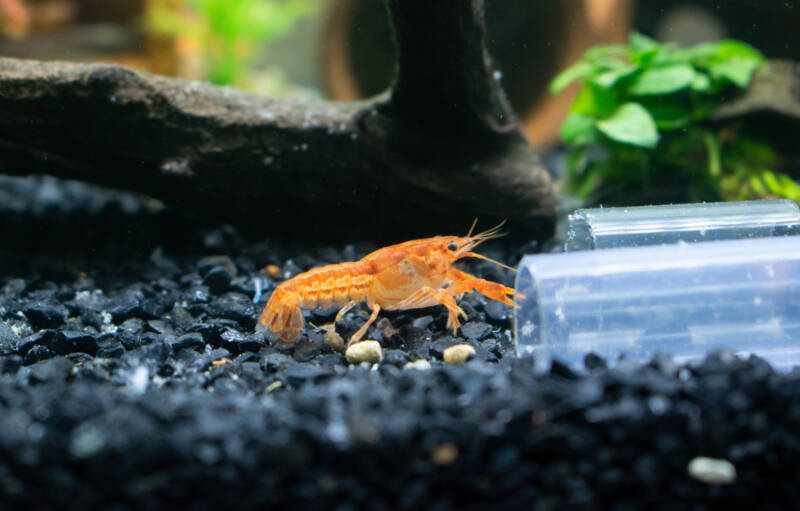
Setting up a tank for your Mexican dwarf crayfish is simple.
Decorations
What substrate do you recommend?
Because crayfish are diggers, line the bottom with a sandy or small gravel substrate.
Use rocks, driftwood, PVC pipe, or other decorations to create shelters.
Set up these hiding spaces in multiple areas of the tank to accommodate territorial behavior.
Do dwarf crayfish destroy plants?
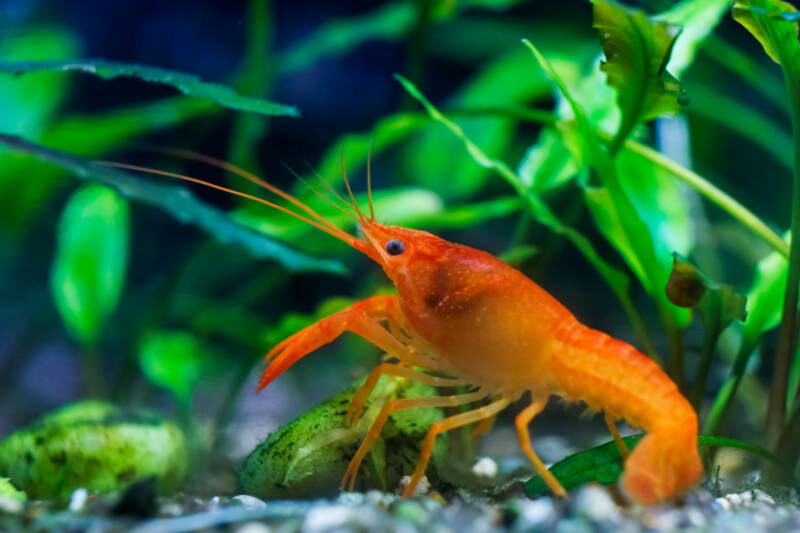
These crayfish do not harm aquarium plants as their diet is meat-based.
However, they can burrow into the substrate and rearrange decorations light enough for them to move. Because they are small, this usually does not present a problem.
They can be paired with mosses, such as marimo moss.
While larger crayfish species destroy these, dwarf crayfish will only pick out food that has fallen on them.
Water Conditions
This species tolerates a wide range of water conditions, but consistent conditions make for the healthiest pets.
Set the water temperature between 60- and 82-degrees Fahrenheit (16 to 28°C) with 65 to 75°F (18-24°C) being ideal.
Remineralized water (reverse osmosis/deionized) is best with a pH level between 6.0 to 8.0 and hardness in the range of 3 to 15 dKH.
Change out around 25 percent of the water every one or two weeks to avoid the buildup of ammonia and nitrates.
Cycle the water several times before you introduce your dwarf crayfish. Test the water to ensure the conditions have stabilized.
Equipment
The tank can be kept at room temperature if the water temperature stays within the range of 65 to 75°F.
A heater is not required unless the ambient room temperature tends to fluctuate. Use a quality water testing kit to make sure the pH stays within the required range.
A sponge filtration system is a safe option for your dwarf crays. Adding an air stone or bubbler will keep the water well oxygenated.
Keep the lighting low or provide floating vegetation for shaded areas.
Tank Mates
The peaceful nature of dwarf crayfish allows them to live with multiple other species in a community tank.
Naturally, certain species should be paired with caution.
While not aggressive, dwarf crays are opportunistic feeders.
They can go after smaller species, such as dwarf freshwater shrimp, and may nip the fins of slow-moving or long-finned fish.
They are best paired with fast swimming or schooling fish, particularly those that occupy the middle to upper levels of the water column.
Consider the following to pair with your dwarf crayfish:
Avoid the following:
- Aggressive, predatorial fish
- Fish with long, flowing fins (your crayfish may nip them if they feel threatened)
Add the following with caution:
- Freshwater shrimp: some crayfish get along fine with various shrimp species while others may not.
- Snails: larger snail species may be fine, but crayfish can prey on smaller ones that do not have trapdoor protection.
- Betta: Although this may seem like a bad match at first, pairing them can work. Make sure that the tank is large enough to give these territorial species enough space. Ten gallons is the minimum tank size for a single betta and dwarf crayfish. Consider short-finned bettas, include plenty of hiding spaces, and adequately feed both species so they do not turn to the other for food.
Can you keep dwarf crayfish together?
Yes, provided you have a large tank and plenty of hiding spaces.
Crayfish are territorial and need these spaces for molting.
Make sure the hiding places are disbursed throughout the tank and do not keep more than a few different crayfish species in the same tank.
Can dwarf crayfish be kept alone?
Yes. The dwarf crayfish can be kept as a single member of its species.
Food and Diet
Dwarf crayfish are omnivores and detritivores that are easy to feed.
They will take both sinking pellets and wafers and will also eat brine shrimp, earthworms, mosquito larvae, and dead organic matter.
Meaty foods can be live, freeze-dried, or frozen. They will eat vegetables, such as broccoli or squash.
These occasional algae eaters will also snack on wafers or algae present in the tank.
Add cuttlebone or ground eggshell to supplement their calcium needs and ensure a strong exoskeleton.
Leave molted shells in the tank for the crayfish to consume as a source of calcium.
Feed your crayfish three to four times per week and no more than once a day.
Experiment with the amount of food given so there is no food excess fouling the water, yet the crayfish have enough food so as not to become aggressive toward other tank inhabitants.
Breeding
Breeding dwarf crayfish can occur successfully in a community tank.
The mother will protect the young until they are ready to leave her.
Set up a separate tank if you feel that the young are in danger of being eaten or to allow the young to develop further after they have left their mother.
The setup and water parameters should be the same as the community tank.
Mating
Dwarf crayfish reach sexual maturity anywhere between 2.5 to three months of age.
The pair will undergo a mating ritual during which the male will transfer semen to the female’s receptacle.
She will fertilize anywhere from 10 to 60 eggs and adhere them beneath her abdomen.
The female will use her swimmerets to keep the eggs clean and well oxygenated.
She will be less active during the time the eggs are developing but will fiercely protect her young from predators and other crayfish.
As the eggs develop, you will begin to see the dark spots of the developing eyes.
Caring for the Young
In three to four weeks, the eggs will hatch and miniature crayfish will emerge.
For the first few days and up to two weeks, the young will stay close to their mother, feeding and quickly returning beneath her tail for protection.
The mother and young communicate through pheromones that the mother releases to encourage the young to remain nearby.
When the young begin to leave the mother, you can either house them separately or make sure there are numerous hiding places to allow them to reach maturity.
At around two months of age, they will reach a length of 0.5 inches (1.3 cm). You will be able to determine the sex of your crayfish at that time.
Once they reach 0.7 inches (1.7 cm) in length, at an age around three to four months, you can house the young with the adults.
Hardiness and Diseases
Dwarf crays are hardy creatures. The biggest risk is infection impacting their exoskeleton, and there are several ways this can happen.
The most common infection is called crayfish plague, which is caused by a fungal infection (Aphanomyces astaci).
This fungus is present in untreated water and the infection can be fatal. Infected crayfish develop black spots on their shell and exhibit unusual behavior.
Isolate the infected crayfish and correct the water conditions that may have caused the infection.
Another fungal infection, known as porcelain disease, is caused by Thelohania spp.
Infected crayfish lose the ability to swim through the hardening of their abdominal muscles and thereby starve to death.
Two additional types of fungus can result in shell rot, which presents as brown or black spots on the exoskeleton.
These lesions eventually expose the underlying tissue, leaving the crayfish vulnerable to secondary infections.
This condition is treatable through isolating the crayfish in a saltwater bath for 10 minutes and thorough cleaning of the aquarium.
Finally, avoid foods or medications containing copper sulfates, which can stunt crayfish growth and inhibit reproduction.
Closing Thoughts
Due to their hardy health and peaceful nature, Mexican dwarf crayfish are ideal additions to the community tanks of both beginner and experienced aquarists.
How much does a dwarf crayfish cost?
The cost per crayfish can range from as low as $8 to just over $15. Some vendors offer discounts if multiple crayfish are purchased.
With proper maintenance of a clean tank, these little “lobsters” will provide visual interest and activity to the bottom of your tank.
We would love to hear from you! What are your favorite decorations to use as hiding spaces for your dwarf crayfish?
